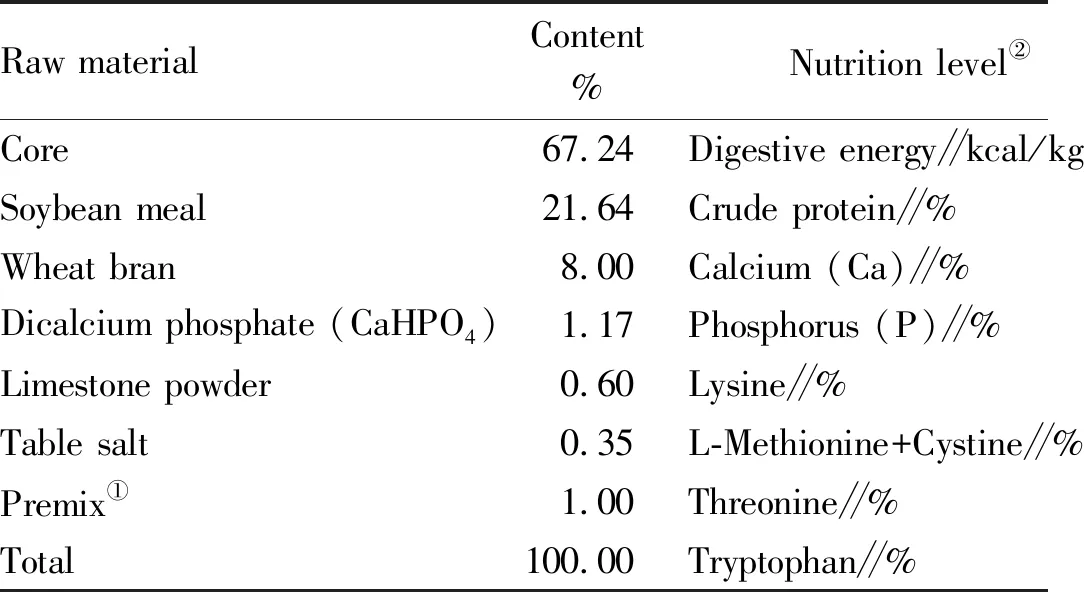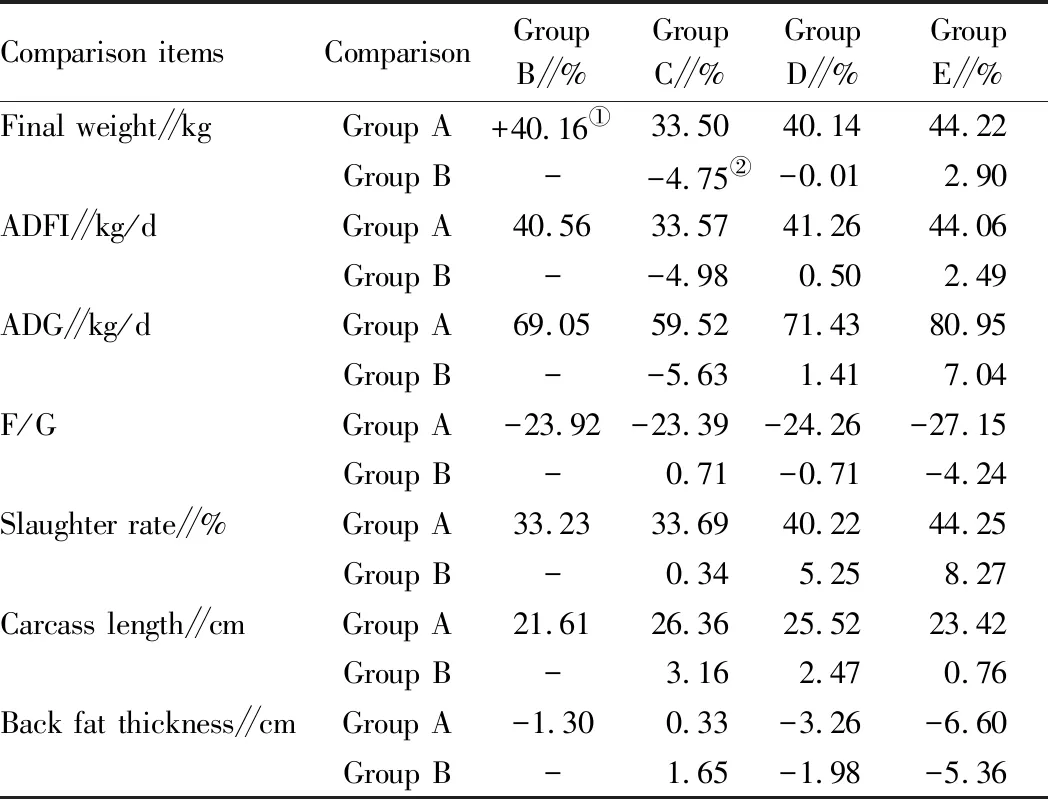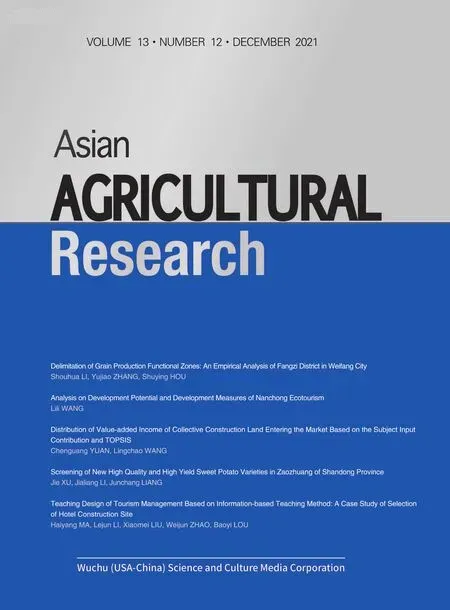Effects of Fermented Nano Chinese Herbal Medicines Replacing Antibiotics on Production Performance and Carcass Quality of Growing-Finishing Pigs
2021-02-18YonglingHUThiThanhHaiNGUYENXiCHENZhenxingZOUJinfengZHONG
Yongling HU, Thi Thanh Hai NGUYEN, Xi CHEN, Zhenxing ZOU, Jinfeng ZHONG
1. College of Bioengineering, Hunan Polytechnic of Environment and Biology, Hengyang 421005, China; 2. Faculty of Animal Science and Veterinary Medicine, Bacgiang Agriculture and Forestry University, Bacgiang 236100, Vietnam
Abstract [Objectives] To study the effects of fermented nano Chinese herbal medicines replacing antibiotics on the production performance and carcass quality of growing-finishing pigs. [Methods] 200 healthy and disease-free Duroc-Landrace-Yorkshire (DLY) growing-finishing pigs with similar birth time (45±2 d) and body weight of about 31.5 kg were randomly divided into group A (fed with non-antibiotic basal diet), group B (fed with antibiotic basal diet), group C (fed with non-antibiotic basal diet+0.1% fermented nano Chinese herbal medicine preparation), group D (fed with non-antibiotic basal diet+0.3% fermented nano Chinese herbal medicine preparation) and group E (fed with non-antibiotic basal diet+0.5% fermented nano Chinese herbal medicine preparation). The experiment lasted for 90 d. At the end of the experiment, the production performance and carcass indicators were measured. [Results] Compared with group A, the final weight, average daily gain (ADG) and average daily feed intake (ADFI) of groups B, C, D and E were extremely significantly increased (P<0.01), while the feed-to-gain ratio (F/G) was extremely significantly decreased (P<0.01). Compared with group B, the ADG of group E was significantly increased (P<0.05), while the F/G was significantly decreased (P<0.05). Compared with group A, the slaughter rate and carcass length of pigs in groups B, C, D and E were extremely significantly increased (P<0.01); compared with group B, the slaughter rate of groups D and E was extremely significantly increased (P<0.01). [Conclusions] The fermented nano Chinese herbal medicine preparation has better effects in promoting growth than that of antibiotic additives, and it can significantly improve the carcass quality of growing-finishing pigs.
Key words Growing-finishing pigs, Fermented nano Chinese herbal medicine preparation, Production performance, Carcass quality
1 Introduction
The Ministry of Agriculture and Rural Affairs of the People’s Republic of China issued an announcement to prohibit the use of all growth-promoting drug feed additives except Chinese herbal medicines as of January 1, 2020. On July 1 of the same year, China started prohibiting the use of commercial feeds containing growth-promoting drug feed additives except Chinese herbal medicines. In this situation, as the only growth-promoting drugs that can be added to feeds, Chinese herbal medicines have attracted more and more attention. Chinese herbal medicine not only has the functions of nutrition, health care and drug treatment, but also has the advantages of pure naturalness, no drug resistance, and small toxic and side effects, so it is a green and safe feed additive. Studies have shown that adding Chinese herbal medicine additives to the daily feed can improve the growth performance of pigs, body immunity, carcass traits and meat qualityandetc.
However, the existing studies are mainly concentrated on the improvement effects of Chinese herbal medicine additives, and there are few reports on the effects of replacing antibiotics. Besides, some active components of Chinese herbal medicines are difficult to dissolve in water or even organic solvents, as a result, large amounts of Chinese herbal medicines produced by traditional processing methods are difficult to keep stable efficacy. Nanotechnology can increase the solubility and leaching rate of Chinese herbal medicines, thereby increasing the utilization rate of Chinese herbal medicines. In addition, using the fermentation technology can degrade the macromolecular substances in Chinese herbal medicines into small molecular substances which can be directly absorbed and utilized by the intestinal tract, thereby improving the efficacy. Therefore, taking the growing-finishing pigs as objects in this experiment, we studied the effects of fermented nano Chinese herbal medicines replacing antibiotics on the production performance and carcass quality of growing-finishing pigs, in order to provide a scientific reference for application and promotion of fermented nano Chinese herbal medicines replacing antibiotics in the swine breeding industry.2 Materials and methods
2.1 Production of fermented nano Chinese herbal medicine preparation
The preparation consists of 30 g of Lonicerae Japonicae Flos, 30 g of Isatidis Radix, 60 g of Dioscoreae Rhizoma, 30 g of Crataegi Fructus, 30 g of Angelicae Sinensis Radix, 50 g of Vaccariae Semen, 40 g of Astragali Radix, 30 g of Isatidis Folium, 60 g of Citri Reticulatae Pericarpium, 30 g of Cinnamomi Cortex, and 110 g of accessories (rice bran), made by the biological fermentation and nanotechnology, and provided by Hunan Polytechnic of Environment and Biology.2.2 Experiment design and feeding management
We selected 200 healthy and disease-free Duroc-Landrace-Yorkshire (DLY) growing-finishing pigs with similar birth time (45 d) and body weight of about 31.5 kg and randomly divided them into five groups. Each treatment had four replicates, and each replicate had 10 pigs. The experiment was carried out from February 7, 2020 to May 7, 2020. Group A was the control group and fed with non-antibiotic basal diet. Other groups were experimental groups, group B was fed with antibiotic basal diet, group C was fed with non-antibiotic basal diet+0.1% fermented nano Chinese herbal medicine preparation, group D was fed with non-antibiotic basal diet+0.3% fermented nano Chinese herbal medicine preparation and group E was fed with non-antibiotic basal diet+0.5% fermented nano Chinese herbal medicine preparation. At the early stage of the experiment, the experimental pigs were disinfected and cleaned, and then immunized and dewormed. During the experiment, the pigs of each group were kept in the same pig house under the same feeding conditions. They were fed twice a day with free intake of food and water.2.3 Experimental diet
The experimental basal diet was a corn-soybean meal type diet, formulated in accordance with the NRC (2012) nutrition standard. The composition and nutrition level of basal diet are indicated in Table 1.
Table 1 Composition and nutrition level of basal diet (air dry basis)
2.4 Testing indicators
2.4.1
Determination of production performance indicators. After starting of the experiment, we made a record of the feeding amount and the remaining amount of feed every day to calculate the average daily feed intake (ADFI). On the morning of the first day and the last day, weighed all the pigs, and calculated the average daily gain (ADG) and feed-to-gain ratio (F/G).2.4.2
Determination of the carcass quality. We measured the slaughter rate, lean meat rate, back fat thickness, eye muscle area, and carcass length in accordance withTechnical
Regulation
for
Testing
of
Carcass
Traits
in
Lean
-type
Pigs
(NY/T 825-2004).2.5 Data processing and statistical analysis
After preliminary statistics on the original data with the aid of Excel, we used SPSS 20.0 statistical software to perform one-way analysis of variance on the data. When the difference is significant, we used Duncan and Least Significant Difference (LSD
) for multiple comparisons. The results are all expressed as "mean±standard error", withP
<0.05 indicating significant difference, andP
<0.01 indicating extremely significant difference.3 Results and analysis
3.1 Effects of fermented nano Chinese herbal medicine preparation on production performance of growing-finishing pigs
From Table 2 and 4, it can be seen there was no significant difference in the initial weight of the experimental pigs among the treatment groups (P
>0.05). After the 90 d experimental period, the final weights of groups B, C, D and E were 40.16% (P
<0.01), 33.50% (P
<0.01), 40.14% (P
<0.01) and 44.22% (P
<0.01) higher than that of group A; the final weight of group C was 4.75% (P
<0.01) lower than that of group B; the final weight of group E was 2.90% (P
<0.01) higher than that of group B. In terms of ADFI, the groups B, C, D, and E were 40.56% (P
<0.01), 33.57% (P
<0.01), 41.26% (P
<0.01), and 44.06% (P
<0.01) higher than group A, while there was no significant difference between groups B, group D, and group E (P
>0.05). In terms of ADG, the groups B, C, D, and E were 69.05% (P
<0.01), 59.52% (P
<0.01), 71.43% (P
<0.01) and 80.95% (P
<0.01) higher than group A, and group E was 7.04% (P
<0.05) higher than group B. In terms of F/G, the groups B, C, D, and E were 23.92% (P
<0.01), 23.39% (P
<0.01), 24.26% (P
<0.01) and 27.15% (P
<0.01) lower than group A, and group E was 4.24% (P
<0.05) lower than group B. The above results indicate that the fermented nano Chinese herbal medicine preparation can significantly improve the production performance of growing-finishing pigs; when the addition amount was 0.3%, the effect is equivalent to that of antibiotic additives, and when the addition amount was 0.5%, the effect is better than that of antibiotic additives.3.2 Effects of fermented nano Chinese herbal medicine preparation on carcass quality of growing-finishing pigs
From Table 3 and 4, it can be known that compared with the control group and antibiotic group, the slaughter rate and carcass length of the fermented nano Chinese herbal medicine preparation group were improved by varying degrees. In terms of the slaughter rate, the groups B, C, D, and E were 33.23% (P
<0.01), 33.69% (P
<0.01), 40.22% (P
<0.01) and 44.25% (P
<0.01) higher than the group A, and groups D and E were 5.25% (P
<0.01) and 8.27% (P
<0.01) higher than group B. In terms of the carcass length, the groups B, C, D, and E were 21.61% (P
<0.01), 26.36% (P
<0.01), 25.52% (P
<0.01) and 23.42% (P
<0.01) higher than the group A, and groups C, D, and E were slightly higher than the group B, but the difference was not significant. In terms of the back fat thickness, the groups D and E were 3.26% and 6.60% lower than the group A, and 1.98% and 5.36% lower than the group B, but both differences were not significant. In addition, there was no significant difference in the eye muscle area and lean meat rate among all groups.
Table 2 Effects of fermented nano Chinese herbal medicine preparation on production performance of growing-finishing pigs

Table 3 Effects of fermented nano Chinese herbal medicine preparation on carcass quality of growing-finishing pigs

Table 4 Comparison of production performance and carcass quality among groups A, B, C, D and E
4 Discussion
4.1 Effects of fermented nano Chinese herbal medicine preparation on production performance of growing-finishing pigs
According to findings of Li Meifaet
al.
and Yang Diet
al.
, adding a certain amount of Chinese herbal medicines to the diet of growing-finishing pigs can significantly increase ADG and reduce the F/G, which are consistent with results of our experiment, indicating that adding Chinese herbal medicines in the diet can improve the production performance of growing-finishing pigs. However, in this experiment, we found that compared with the control group, the fermented nano Chinese herbal medicine preparation group greatly increased the ADG and F/G of experimental pigs, possibly because the experiment was carried in Vietnam where the breeding environment is different from Chinese environment. According to the study of Hu Yonglinget
al.
, adding 1%, 2%, and 3% levels of micro-nano Chinese herbal medicine preparations to the diet of growing-finishing pigs could significantly increase ADG, and it increased by 4.92%, 11.47% and 8.20%, respectively, compared with the antibiotic group. In this experiment, compared with the antibiotic group, the ADG of the diet added with 0.3% and 0.5% fermented nano Chinese herbal medicine preparations increased by 1.41% and 7.04%, respectively, and F/G decreased by 0.71% and 4.24%, respectively, showing that the fermented nano Chinese herbal medicine can improve the production performance of growing-finishing pigs and the effect was better than antibiotic additives, which are consistent with research conclusions of Hu Yonglinget
al.
Through studying the in vitro antibacterial effects of 20 Chinese herbal medicine extracts on 4 common pathogens, Lu Biaoet
al.
found that many Chinese herbal medicines have antibacterial effects. Another study shows that compound Chinese herbal medicine additives can improve the apparent digestibility of crude protein and acid detergent fiber in feed, and enhance the absorption of protein and glucose by pigs. Antibiotics also have the effect of inhibiting bacteria and promoting the absorption of nutrients by animals. Therefore, Chinese herbal medicine can improve the production performance of pigs, and the effect is comparable to that of antibiotics, which is possibly related to its ability to inhibit intestinal pathogenic bacteria, promote intestinal health, and improve the digestion and absorption of nutrients in feed. In addition, fermentation can increase the content of various nutrient active substances such as crude protein, crude fat, polyphenols, and flavonoids in Chinese herbal medicines, thereby increasing the medicine efficacy, which may be the reason why Chinese herbal medicines can significantly improve the performance of growing-finishing pigs in this experiment.4.2 Effects of fermented nano Chinese herbal medicine preparation on carcass quality of growing-finishing pigs
The slaughter rate, lean meat rate, back fat thickness, eye muscle area and carcass length are all important indicators reflecting the quality of pig carcass, and are closely related to pig meat production. Due to the African Swine Fever (ASF) epidemic, it has gradually become a trend that "regulating pigs" has changed to "regulating meat", prompting many swine breeding enterprises to extend the industrial chain and begin to deploy slaughter business. Therefore, the quality of pig carcass has been receiving more and more attention by the swine breeding industry. Cai Linget
al.
added 0.2%-0.4% Chinese herbal medicine extracts made from Lonicerae Japonicae Flos, Astragali Radix, Crataegi Fructus,etc.
to the feed, and found that it could significantly improve the slaughter rate and eye muscle area of growing-finishing pigs, and the improvement effect was better than that of the virginiamycin group. Wang Hongjunet
al.
found that adding compound additives composed of 11 Chinese herbal medicines such as Shenqu (Medicated Leaven) and Aurantii Fructus could increase the lean meat rate and eye muscle area of pig carcass, and reduce the thickness of carcass back fat. According to findings of Wu Ligang, compared with the control group, powders made from Chinese herbal medicines such as Negundo Chastetree Fruit and Polygoni Multiflori Radix had no significant effect on the slaughter rate and back fat thickness of growing-finishing pigs, but the lean meat rate and eye muscle area were increased by 5.12% and 12.36%, respectively. As indicated by studies of Sui Minget
al.
, compared with the control group, the compound Chinese herbal medicine fermented with 1.0%-2.0% probiotics in the feed had no significant effect on the slaughter rate and carcass oblique length of growing-finishing pigs, but when the addition amount was 1.5%-2.0%, the lean meat rate would increase, and the back fat would decrease. The results of Zeng Shenghongshowed that the addition of two compound Chinese herbal medicines to the feed had no significant effect on the carcass weight, slaughter rate, back fat thickness and eye muscle area of growing-finishing pigs. In this experiment, the slaughter rate and carcass length of the fermented nano Chinese herbal medicine preparation group were significantly higher than those of the control group, and when the fermented nano Chinese herbal medicine preparation was added at 0.3% and 0.5%, the slaughter rate was significantly higher than that of the antibiotic group, but each group has no significant differences in eye muscle area, lean meat percentage and back fat thickness. However, there were no significant differences in eye muscle area, lean meat rate and back fat thickness among the groups. These indicate that the results of the above-mentioned different experiments on the effect of Chinese herbal medicine on pig carcass are not consistent. The reason may be related to the composition of Chinese herbal medicines, the content of active components, and the different production and processing methods. The mechanism still needs further study.5 Conclusions
Under the conditions of this experiment, adding fermented nano Chinese herbal medicine to the basic diet can significantly improve the production performance and improve the carcass quality of growing-finishing pigs. And the improvement effect is better than that of antibiotics. Especially, adding at 0.5% level has the optimal improvement effect.
杂志排行
Asian Agricultural Research的其它文章
- Research and Application Progress of Silk Fibroin Membranes
- Application Potential of Quinoa as Forage
- The Agriculture-Tourism Integration to Promote the Rural Revitalization: Taking Tea Industry-Agriculture-Tourism in Lishui City as an Example
- Delimitation of Grain Production Functional Zones: An Empirical Analysis of Fangzi District in Weifang City
- Research on the Curriculum Construction by Promoting Teaching Using Competition Based on Bloom’s Taxonomy of Educational Objectives
- Screening of New High Quality and High Yield Sweet Potato Varieties in Zaozhuang of Shandong Province
